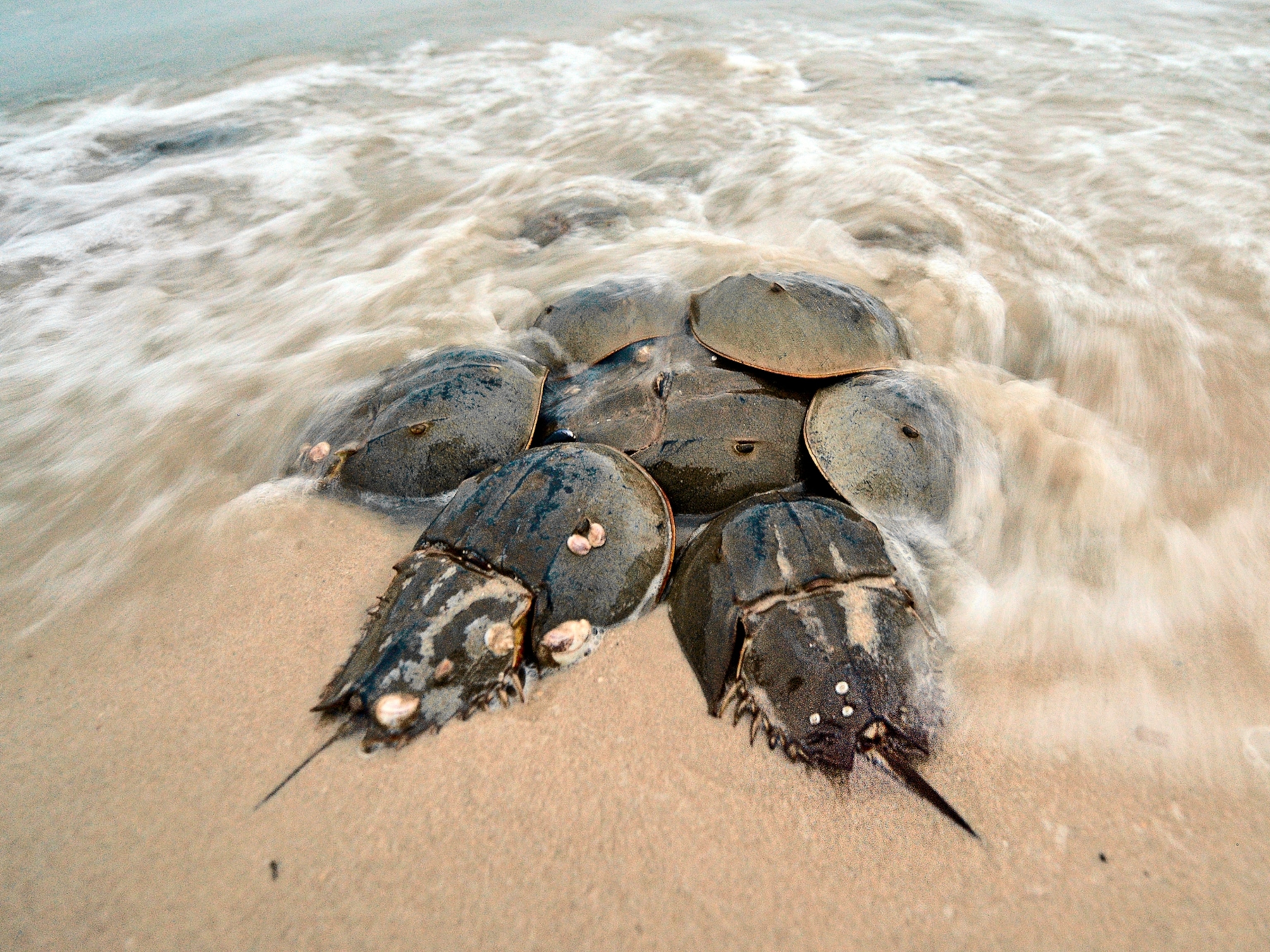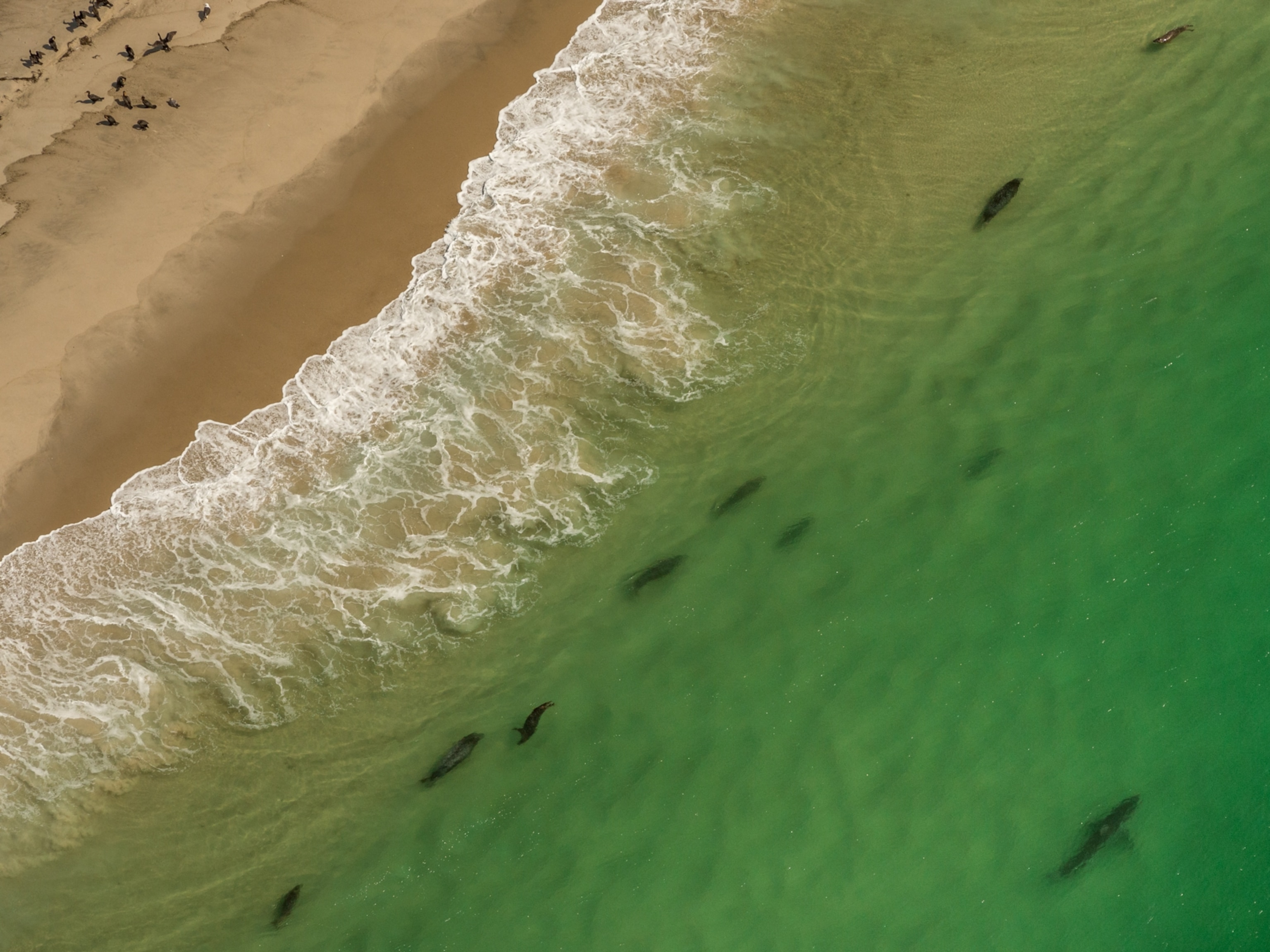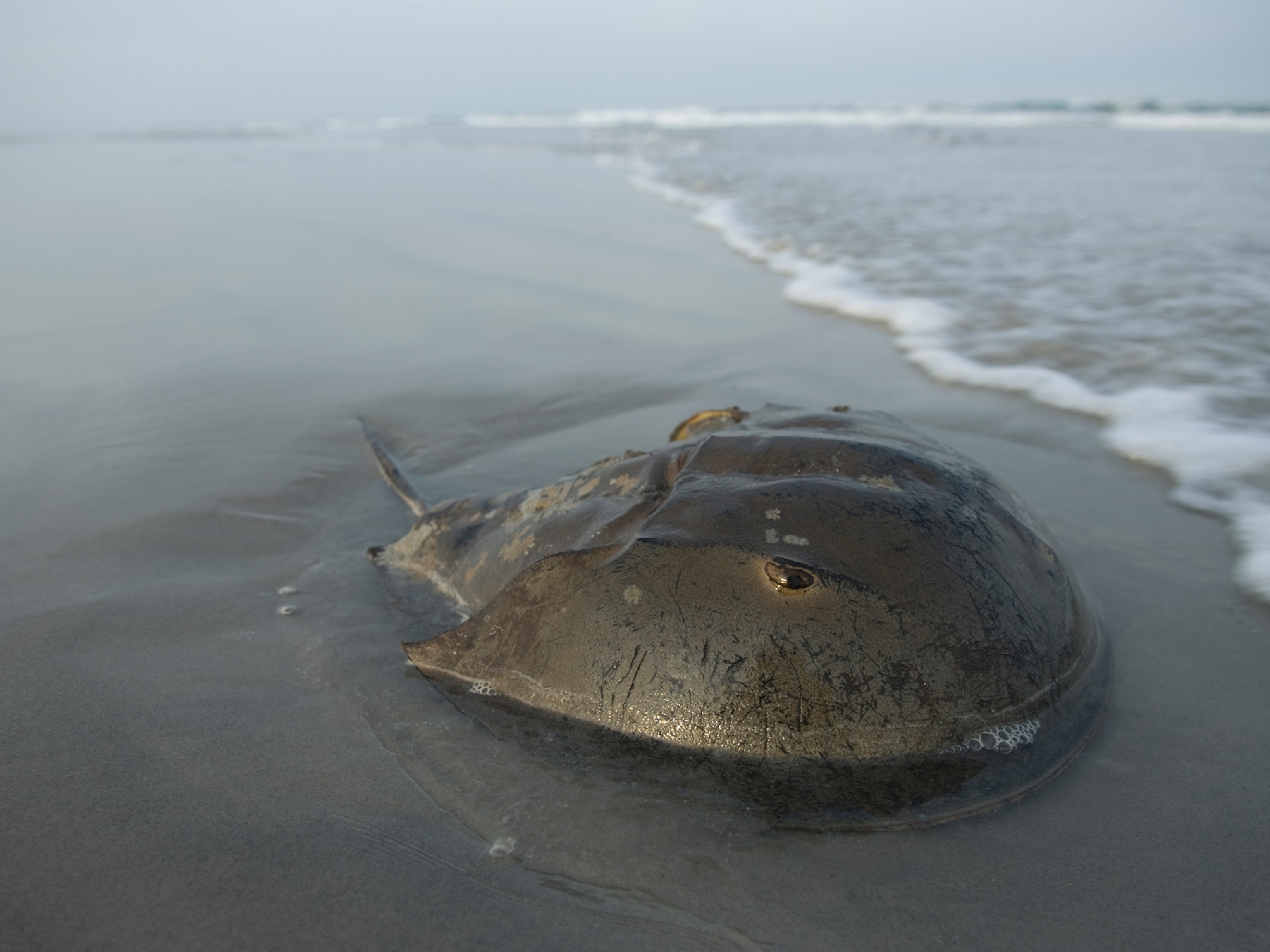
Horseshoe crab blood saves lives. Can we protect these animals from ourselves?
Humans rely on the animal’s blood for lab testing, but the full repercussions of the industry are still not understood.
Delaware Bay — For such a resilient species, the horseshoe crab appears surprisingly helpless.
Beached upon a remote Delaware shoreline after scrambling ashore to mate, one animal’s 10 lobster-like legs wriggle in the air. The crab curls its spear-like tail toward its shell again and again in an attempt to right itself, without success. Soon, it’s exhausted.
Its tail slowly droops toward the sand.
The sandy beach is studded with dozens more crabs in similar predicaments. Some will be rescued by the tide or a passing human; others will die.
But even those that survive may soon face heightened pressures because of the growing global demand for their blue blood, which is harvested for biomedical use worldwide. The arachnids’ toxin-sensitive blood is the only known natural source of amebocyte lysate, a clotting agent used to detect dangerous endotoxins in a variety of human medical products, including insulin, intravenous devices, and COVID vaccines.
The Atlantic horseshoe crab and three Asian species of horseshoe crabs have existed largely unchanged for at least 450 million years, well before the dinosaurs. Yet dwindling numbers of wild horseshoe crabs in Asia, exacerbated by booming demand in the Asia-Pacific biomedical market, threaten to shift the industry even more to the Atlantic horseshoe crab, according to conservation groups and biomedical companies.
The International Union for the Conservation of Nature, which determines the conservation status of wildlife, considers Atlantic horseshoe crabs to be vulnerable, citing evidence that the crab’s numbers are declining. But the full implications from horseshoe crab bleedings and subsequent mortality—especially on top of other threats such as climate change, soil erosion, and fishing for the bait industry—remains hard to know.
Lonza is one of the five U.S. companies that captures Atlantic horseshoe crabs, bleeds them, and then returns them to the Atlantic Ocean each year. It warned in a recent report that increased need for horseshoe crab blood, driven partly by the emergence of personalized medicine such as cell and gene therapies, may place “too great a burden” on the Atlantic species.
Already, the U.S. companies have been steadily increasing their horseshoe crab bleedings each year. In 2020 alone, almost 700,000 horseshoe crabs were captured along the entire Atlantic coastline and taken to laboratories to be bled. More than 100,000 died, according to an estimate from the Atlantic States Marine Fisheries Commission (ASMFC), the group that oversees the horseshoe crab industry.

By comparison, only 480,000 Atlantic horseshoe crabs were captured in 2010, with about 69,000 deaths. The annual death tolls include both observed deaths and an assumed 15 percent unseen mortality rate, though some critics say that number doesn’t completely capture related deaths. One study put the unseen mortality rate from bleedings higher—at 30 percent—saying earlier works did not mimic true crab handling practices, among other factors.
The climbing toll from the crab-bleeding industry raises questions about our obligations to the animals that supply life-saving materials for human benefit, especially when there’s a synthetic alternative to amebocyte lysate, called recombinant factor C (rFC), available, says Christian Hunt, who leads horseshoe crab policy at Defenders of Wildlife.
Without better oversight of horseshoe crab bleedings and outcomes, he says, “It’s the Wild West for the biomedical industry.”
Fishing for blue-blooded animals
In recent years, a few U.S. drug companies increasingly have used rFC to ensure the safety of their products. The U.S. Food and Drug Administration allows companies to swap in this synthetic on a case-by-case basis if they provide evidence that the results are comparable to the crab-sourced material.
The U.S. Pharmacopeia, an independent scientific group that develops quality standards for FDA-approved products, says despite those earlier approvals it’s still reasonable for the agency to require additional validation before approving rFC-based testing (even though it does increase costs to drug companies).
“We are in an interim period of time while the rFC-based methods are being adopted,” it said in a public statement, adding in a separate statement to National Geographic that the group is committed to moving toward animal-free approaches whenever possible.
So far, none of the five U.S. companies that harvest Atlantic horseshoe crabs has announced plans to fully transition their businesses to rFC. The companies are scattered along the East Coast: Associates of Cape Cod in Massachusetts, Limuli Labs in New Jersey, Lonza in Maryland; Fujifilm Wako Chemicals in Virginia; and Charles River Laboratories in South Carolina and Massachusetts.
Each spring, these companies hire fishers to scoop up the crabs when the arthropods come ashore to spawn. Workers truck their live catch to the company’s labs. Each lab’s protocols vary, but generally the animals are cleaned, the barnacles and sea detritus pried from their shells, and a large needle is inserted into their bodies. Their extracted blue blood then drips out into bottles placed directly below the animal. Workers outfitted in lab coats, hair nets, and masks oversee the procedure—extracting roughly a third of each animal’s blood. Then the crabs are returned to the wild.
In Asia, the crabs often are bled to death and then sold to be eaten, rather than just partially bled as they are in North America. Lack of harvest regulations for the Asian crabs is a significant source of the species’ decline, according to the IUCN. The tri-spine horseshoe crab, the primary target for the biomedical bleedings in Asia, is endangered, while the conservation status of the other two Asian species is uncertain.
It's unclear how many Atlantic horseshoe crabs exist overall, since there are no population counts.
There’s also no public accounting of how many horseshoe crabs are caught for this industry at the state level—or die from it—because of business-confidentiality policies enshrined in U.S. law. Instead, only broad estimates for the entire Atlantic coast, based on the companies’ self-reported data, is publicly released by ASMFC.
Larry Niles, a migratory shorebird expert with the New Jersey-based Wildlife Restoration Partnerships, a consultancy organization that promotes habitat restoration, says he’s concerned about the trustworthiness of self-reported data from the biomedical companies.
“There’s no one verifying any of the data; there are no state people or ASMFC people going to the labs,” he says. “We don’t know how many crabs the blood industry is killing.”
“We know what the [harvest and mortality] numbers are—it’s not a secret,” says Kristen Anstead, a stock assessment scientist at the ASMFC.
“The facilities give those numbers to the respective states and then they gave it to us. It’s a public relations problem, but it’s not a mathematical problem or a management problem,” Anstead says. The reason the commission doesn’t share this data publicly is to ensure that competitors cannot ascertain details about each other’s operations that would undermine their businesses, but she and other number crunchers have access to all the data, Anstead says.
Atlantic horseshoe crabs are not endangered, she adds, though some specific populations—such as those living in certain bays—may be experiencing some declines that are not yet well understood, she says.
There’s no public accounting of how many horseshoe crabs are caught for this industry at the state level—or die from it—because of business-confidentiality policies enshrined in U.S. law.
Scientists say there are other repercussions of the biomedical bleeding industry: Several studies show bled crabs are more lethargic and perhaps disoriented for weeks after the bleeding, which may impede their ability or desire to come to shore to spawn.
That’s particularly worrisome because the animals are removed during the breeding season, says Win Watson, an emeritus professor at the University of New Hampshire who has spent decades studying horseshoe crabs and the sub-lethal effects of bleedings.
Passing the kill threshold
When monitoring of the Atlantic horseshoe crab industry began decades ago, regulators at the ASMFC set a threshold for horseshoe crab mortality caused by the biomedical industry, saying the board may consider taking action if the bleeding mortality rate exceeded 57,000 deaths per year in the U.S.
That limit’s been surpassed almost every year since 2007. But the industry that relies on crab-bleeding has continued to grow without any formal reevaluation.
“There isn’t scientific analysis showing biomedical mortality having a significant negative impact on the horseshoe crab population, so the board has not felt it’s warranted to take action,” says Caitlin Starks, senior fishery management plan coordinator at ASMFC.
The organization, which oversees a variety of fisheries, classifies the current Atlantic horseshoe crab status as “neutral” rather than its other categories of “good” or “poor.” The reason? It says there’s “a combination of positive and negative trends.”
Niles, the shorebird expert, says that type of categorization is obtuse and isn’t meaningful for conservation efforts or understanding management needs. “It’s good for the people who want to keep killing,” he says.
Concerned about Atlantic horseshoe crab declines, the nonprofit groups Defenders of Wildlife, Coastal Conservation League, and Southern Environmental Law Center filed a lawsuit in 2022 against South Carolina’s Department of Natural Resources and Charles River Laboratories, alleging that the animals caught for the biomedical company’s use are treated poorly and kept in “overcrowded, unsanitary conditions” where thousands of the animals die.
It states that the animals languish in artificial containment ponds for weeks without food before they’re bled, a practice that they claim violates the Endangered Species Act because it threatens a protected bird species that relies on the crabs for food—the red knot.
Some red knots migrate from South America to the Arctic, for example, and replace around half of their body weight by dining on Atlantic horseshoe crabs’ olive-green eggs.
Watching population trend lines
The nonprofits also say that because the synthetic alternative rFC is now available and in use, Charles River Laboratories and other biomedical companies should work to phase out crab use altogether.
There is a precedent for such a move. Pharmaceutical giant Eli Lilly started shifting all the products that require endotoxin testing to rFC back in 2016, according to Jay Bolden, a director and endotoxin testing expert at the company.
“The original reason, the main reason, was supply chain,” he says, noting that he was worried about the drop in Asian horseshoe crab populations and subsequent pressures on Atlantic stock.
The FDA approved the first drug that used a rFC-based endotoxin test in 2018, an Eli Lilly migraine therapy. Now, 80 percent of Eli Lilly’s endotoxin tests rely on the synthetic equivalent, and Bolden says the rFC product works “as well or better” than the natural alternative. (Eli Lilly’s remaining endotoxin-testing needs are met with crab-sourced material from companies including Charles River Laboratories, he says.)
Charles River Laboratories says that it’s also investing in synthetics-related research and development.
“We will continue to defend our work and balance the health of the horseshoe crab population and our responsibility to protect patient safety and the medical supply chain from potentially fatal contamination,” the company said in a statement.
A shot at survival
Meanwhile, efforts to understand and perhaps alleviate some of the sub-lethal effects of the bleedings are underway.
Watson and colleagues, in one unpublished study, put transmitters on Atlantic horseshoe crabs and tracked them during the breeding season—following 10 females that were bled and 10 that were not. This new work confirms previous research that indicated bled crabs tried to approach beaches to spawn less frequently, he says.
His team is also studying how to counter some of the deleterious effects of bleedings. One idea, he says, is pumping the animals full of nutrients before returning them to the wild. Watson theorizes that the crabs may experience reduced oxygen flow due to heat exposures during transport to the lab, which is then worsened by the extreme blood loss.
To test this idea, Watson’s team has caught dozens of horseshoe crabs in New Hampshire, bled them, and then kept them in a tank to feed them and let them recuperate for two weeks before returning them to the ocean. The approach is somewhat reminiscent of making sure human blood donors are rejuvenated with cookies and juice. “The fed animals did better,” as measured by their levels of hemocyanin—a protein that transports oxygen in the blood, he says, though he notes the crabs’ hemocyanin levels still didn’t fully return to their pre-bled baseline from when they were caught.
Despite these encouraging results, which haven’t yet been peer-reviewed, biomedical companies may not want to keep the animals around for much time after they’ve been bled, he says, so it may be more practical to treat them ahead of the bleedings—keeping them overnight in tanks of cool, food-rich seawater before they’re bled. That might increase their survival rates, he says.
The lifesaving value of horseshoe blood is undeniable, Watson says, but we could make “bleedings a more sustainable practice.” Improving the animal’s baseline health, he hopes, may do just that.
Related Topics
You May Also Like
Go Further
Animals
- How can we protect grizzlies from their biggest threat—trains?How can we protect grizzlies from their biggest threat—trains?
- This ‘saber-toothed’ salmon wasn’t quite what we thoughtThis ‘saber-toothed’ salmon wasn’t quite what we thought
- Why this rhino-zebra friendship makes perfect senseWhy this rhino-zebra friendship makes perfect sense
- When did bioluminescence evolve? It’s older than we thought.When did bioluminescence evolve? It’s older than we thought.
- Soy, skim … spider. Are any of these technically milk?Soy, skim … spider. Are any of these technically milk?
Environment
- Are the Great Lakes the key to solving America’s emissions conundrum?Are the Great Lakes the key to solving America’s emissions conundrum?
- The world’s historic sites face climate change. Can Petra lead the way?The world’s historic sites face climate change. Can Petra lead the way?
- This pristine piece of the Amazon shows nature’s resilienceThis pristine piece of the Amazon shows nature’s resilience
- Listen to 30 years of climate change transformed into haunting musicListen to 30 years of climate change transformed into haunting music
History & Culture
- Meet the original members of the tortured poets departmentMeet the original members of the tortured poets department
- Séances at the White House? Why these first ladies turned to the occultSéances at the White House? Why these first ladies turned to the occult
- Gambling is everywhere now. When is that a problem?Gambling is everywhere now. When is that a problem?
- Beauty is pain—at least it was in 17th-century SpainBeauty is pain—at least it was in 17th-century Spain
Science
- Here's how astronomers found one of the rarest phenomenons in spaceHere's how astronomers found one of the rarest phenomenons in space
- Not an extrovert or introvert? There’s a word for that.Not an extrovert or introvert? There’s a word for that.
- NASA has a plan to clean up space junk—but is going green enough?NASA has a plan to clean up space junk—but is going green enough?
- Soy, skim … spider. Are any of these technically milk?Soy, skim … spider. Are any of these technically milk?
Travel
- This tomb diver was among the first to swim beneath a pyraamidThis tomb diver was among the first to swim beneath a pyraamid
- Dina Macki on Omani cuisine and Zanzibari flavoursDina Macki on Omani cuisine and Zanzibari flavours
- How to see Mexico's Baja California beyond the beachesHow to see Mexico's Baja California beyond the beaches
- Could Mexico's Chepe Express be the ultimate slow rail adventure?Could Mexico's Chepe Express be the ultimate slow rail adventure?







